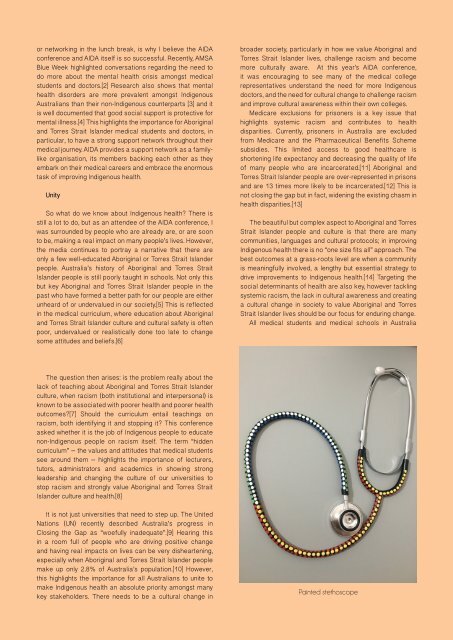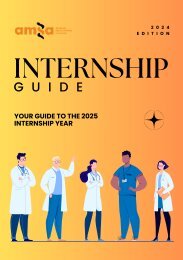Vector Volume 11 Issue 2 - 2017
You also want an ePaper? Increase the reach of your titles
YUMPU automatically turns print PDFs into web optimized ePapers that Google loves.
or networking in the lunch break, is why I believe the AIDA<br />
conference and AIDA itself is so successful. Recently, AMSA<br />
Blue Week highlighted conversations regarding the need to<br />
do more about the mental health crisis amongst medical<br />
students and doctors.[2] Research also shows that mental<br />
health disorders are more prevalent amongst Indigenous<br />
Australians than their non-Indigenous counterparts [3] and it<br />
is well documented that good social support is protective for<br />
mental illness.[4] This highlights the importance for Aboriginal<br />
and Torres Strait Islander medical students and doctors, in<br />
particular, to have a strong support network throughout their<br />
medical journey. AIDA provides a support network as a familylike<br />
organisation, its members backing each other as they<br />
embark on their medical careers and embrace the enormous<br />
task of improving Indigenous health.<br />
Unity<br />
So what do we know about Indigenous health? There is<br />
still a lot to do, but as an attendee of the AIDA conference, I<br />
was surrounded by people who are already are, or are soon<br />
to be, making a real impact on many people’s lives. However,<br />
the media continues to portray a narrative that there are<br />
only a few well-educated Aboriginal or Torres Strait Islander<br />
people. Australia’s history of Aboriginal and Torres Strait<br />
Islander people is still poorly taught in schools. Not only this<br />
but key Aboriginal and Torres Strait Islander people in the<br />
past who have formed a better path for our people are either<br />
unheard of or undervalued in our society.[5] This is reflected<br />
in the medical curriculum, where education about Aboriginal<br />
and Torres Strait Islander culture and cultural safety is often<br />
poor, undervalued or realistically done too late to change<br />
some attitudes and beliefs.[6]<br />
broader society, particularly in how we value Aboriginal and<br />
Torres Strait Islander lives, challenge racism and become<br />
more culturally aware. At this year’s AIDA conference,<br />
it was encouraging to see many of the medical college<br />
representatives understand the need for more Indigenous<br />
doctors, and the need for cultural change to challenge racism<br />
and improve cultural awareness within their own colleges.<br />
Medicare exclusions for prisoners is a key issue that<br />
highlights systemic racism and contributes to health<br />
disparities. Currently, prisoners in Australia are excluded<br />
from Medicare and the Pharmaceutical Benefits Scheme<br />
subsidies. This limited access to good healthcare is<br />
shortening life expectancy and decreasing the quality of life<br />
of many people who are incarcerated.[<strong>11</strong>] Aboriginal and<br />
Torres Strait Islander people are over-represented in prisons<br />
and are 13 times more likely to be incarcerated.[12] This is<br />
not closing the gap but in fact, widening the existing chasm in<br />
health disparities.[13]<br />
The beautiful but complex aspect to Aboriginal and Torres<br />
Strait Islander people and culture is that there are many<br />
communities, languages and cultural protocols; in improving<br />
Indigenous health there is no “one size fits all” approach. The<br />
best outcomes at a grass-roots level are when a community<br />
is meaningfully involved, a lengthy but essential strategy to<br />
drive improvements to Indigenous health.[14] Targeting the<br />
social determinants of health are also key, however tackling<br />
systemic racism, the lack in cultural awareness and creating<br />
a cultural change in society to value Aboriginal and Torres<br />
Strait Islander lives should be our focus for enduring change.<br />
All medical students and medical schools in Australia<br />
The question then arises: is the problem really about the<br />
lack of teaching about Aboriginal and Torres Strait Islander<br />
culture, when racism (both institutional and interpersonal) is<br />
known to be associated with poorer health and poorer health<br />
outcomes?[7] Should the curriculum entail teachings on<br />
racism, both identifying it and stopping it? This conference<br />
asked whether it is the job of Indigenous people to educate<br />
non-Indigenous people on racism itself. The term “hidden<br />
curriculum” – the values and attitudes that medical students<br />
see around them – highlights the importance of lecturers,<br />
tutors, administrators and academics in showing strong<br />
leadership and changing the culture of our universities to<br />
stop racism and strongly value Aboriginal and Torres Strait<br />
Islander culture and health.[8]<br />
It is not just universities that need to step up. The United<br />
Nations (UN) recently described Australia’s progress in<br />
Closing the Gap as “woefully inadequate”.[9] Hearing this<br />
in a room full of people who are driving positive change<br />
and having real impacts on lives can be very disheartening,<br />
especially when Aboriginal and Torres Strait Islander people<br />
make up only 2.8% of Australia’s population.[10] However,<br />
this highlights the importance for all Australians to unite to<br />
make Indigenous health an absolute priority amongst many<br />
key stakeholders. There needs to be a cultural change in<br />
Painted stethoscope<br />
45

















